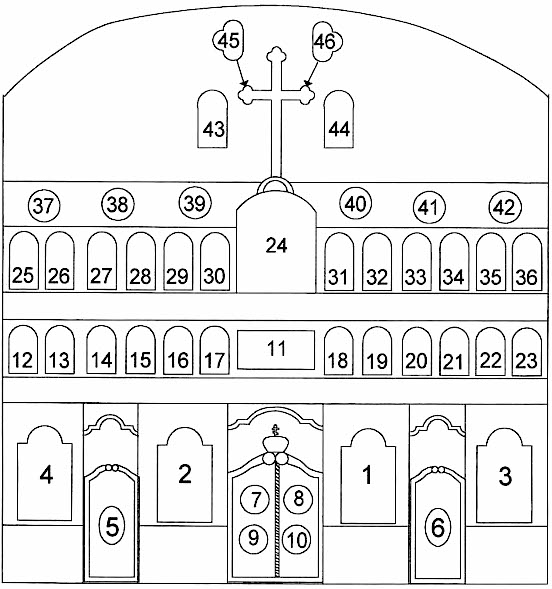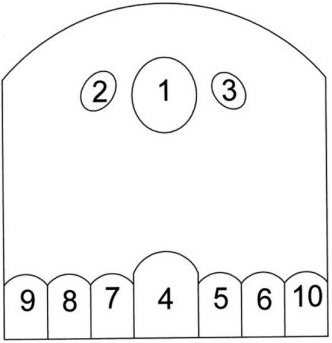Iconostasis & Holy Place Ikons
Iconostasis
The iconostasis (sl: ikonostas), or icon screen, is one of the most important architectural features of Eastern Christian churches. It is an unbroken screen, composed of icons, that separates the sanctuary, where the sacrament of Eucharist is celebrated, from the central part, or nave, where the congregation stands. While the ikonostas symbolically separates the heavenly world (the altar area) from the human world (the main body of the church) it also unites these two worlds into one.
The ikonostas of St. Mary's church is a full Slavic ikonostas consisting of three doors and four tiers of icons. The icon screen has double doors in the center and single doors on either side. The double doors are called the Royal or Holy Doors because the Holy Eucharist and only the bishop or priests can pass through them. They are decorated with icons of the four evangelists Luke, Matthew, Mark, and John. These doors are most often also decorated with an icon of the Annunciation. The Royal Doors also represent the gates of Heaven.
The single doors on either side of the Royal Doors are known as the Deacon door and the Service door. The Deacon door, to the right of the Royal Doors, is decorated with an icon St. Stephen the Protomartyr, while the Service door, to the left of the Royal Doors, is decorated with an icon of St. Michael the Archangel.
In addition to the icons on the doors, the first tier also contains four Main Icons, (Namistnyi Ikony) in Slavonic. To the immediate right of the Royal Doors is an icon of Jesus Christ, Pantocrator, while to the far right is an icon of the patron saint of the parish, in this case the icon of the Protection of the Mother of God (Pokrova). To the immediate left of the Royal Doors is the icon of the Virgin and Child. At the far left is an icon of St. Nicholas the patron saint of the the Byzantine church. If the parish has St. Nicholas as their patron saint then an icon of St. John the Baptist usually occupies the far left position of the first tier.
The second tier of the ikonostas contains icons of the twelve major feast days of the Byzantine liturgical year, with an icon of the Mystical Supper in the middle. The icon of the Mystical Supper is given a place of prominence, directly above the Royal Doors, since this event is reenacted during every Liturgy and should be a focal point of the ikonostas. The major feast days depicted to the left of the Mystical Supper icon are (left to right) Dormition of the Mother of God; Descent of the Holy Spirit (Pentecost); Presentation of Christ in the Temple; Annunciation; Presentation of Mary in the Temple; and The Nativity of Mary. To the right of the Mystical Supper icon the major feasts are as follows (left to right) The Nativity of Jesus Christ; Baptism of Christ (Epiphany); Transfiguration; Entry into Jerusalem (Palm Sunday); Ressurection; and Ascension.
The third tier of icons is that of the Apostles of Christ namely, (left to right) St. Thaddeus (Jude); St. James, the son of Zebedee; St. Thomas; St. Simon; St. Andrew; St. Peter; St. Paul; St.James, the brother of the Lord; St. Phillip; St. Bartholomew; St. Matthew; and St. John.
The fourth tier consists of icons of the Old Testament prophets and patriarchs shown in groups of two namely (left to right) (Zecharius & Samuel); (Daniel & Habakkuk); (Moses & David); (Solomon & Ezekiel); (Haggai & Elias); and (Elisha & Zechariah).
Betwen the third and fourth tiers, and above the icon of the Mystical Supper, is a large icon of Jesus Christ, the High Priest, seated on a throne as Lord of the Universe. Above the large icon of Christ is a cross with an icon of the Crucifixion. To the left of the cross is an icon of the Mother of God, while to the right is an icon of St. John the Evangelist. On the horizontal cross arm are affixed icons of St. Constantine (left) and St. Helena (right).
This full, Slavic, ikonostas, in addition to the icons, is constructed with intricately carved wooden grapevines with long intertwined branches, wide leaves and clusters of grapes that symbolize our union with Christ Who said "I am the vine and you are the branches". (John 15:5)

Holy Place Ikons
The Holy Place (altar area) represents the glory of God. The Holy Table at its center represents the throne of God. As such it is covered with rich fabrics, representing God ‘clothed in majesty‘ (Psalm 92). The walls of the Holy Place are decorated with an array of special icons placed in specific positions as prescribed by the holy canons of the Church.
Let us now look at the newly appointed icons of the Holy Place of St. Mary’s Protection written by the hand of the iconographer Ivan Rumayantzev.
Beginning at the very top of the Holy Place, in the curve of the apse is the icon of the Mother of God, Platitera (#1). Platitera is a Greek word meaning ‘broader’ than the heavens and comes from the ponderous idea that Christ who is broader than all the heavens contained Himself within the Virgin’s womb. Her image is flanked by two angels (#2 and #3) who hold rapidia, the processional fans which denote a rank of honor to Him who is contained within the Holy Virgin. She stands directly above the Holy Table watching each and every Divine service, which makes us partakers of the Heavenly Kingdom.
Directly behind the Holy table is the icon of Christ, the High Priest (#4) so called because he is dressed in the vestments of a bishop. His presence there reminds us that he is the true celebrant of the Divine Liturgy offering us Himself in theBody and Blood of the holy Eucharist. As we sing throughout the Liturgy that all the heavenly powers are present with us, so Christ is surrounded by the angelic hosts again holding symbols of honor, the same rapidia that also flank the Holy Table itself.
The High Priest is surrounded by the four great liturgical fathers of the Church who composed the main liturgies that are used throughout the church year.
To our right of Christ is Saint John Chrysostom, the Golden Tongued (#5). He lived in the fourth century and wrote the Divine Liturgy used on most Sundays and weekdays of the year. Next to Saint John is the image of Saint James, Brother of God (#6). He is the stepbrother of Christ who according to the Book of acts became the first bishop of Jerusalem after Pentecost and composed one of the earliest liturgies of the Church. It is only used by some Byzantine churches at his feast on October 23rd. Several other Eastern Churches also use this liturgy on a more regular basis.
To our left of the High Priest is Saint Basil the Great, bishop of Caesaria in Cappadocia (#7). He was a contemporary of Saint John Chrysostom and is credited with composing an earlier liturgy atill used on his feastday (January 1st), Theophany, the Sundays of Great Lent, and several other times during the liturgical year. At the side of Saint basil is Saint Gregory, the Dialogist, Bishop of Rome (#8), a sixth century Church Father who wrote the Liturgy of the Presanctified Gifts used during the weekdays of the Great Fast.
Thus these four great liturgical fathers have provided the Byzantine Church with a wealth of prayer life, establishing some of the most profound and beautiful services of the Christian Church.
Next to Saint Gregory over the Table of Preparation is an icon of the Nativity of Christ (#9). Just as the bread and wine areprepared by the priest to become the body and Blood of Christ, so did Christ prepare for our salvation through His death and Resurrection by taking on human flesh at His birth. It is a truly great meditation for the priest celebrating the Rite of Preparation at each divine Liturgy. Directly across fromthe Nativity icon by the icon of saint james is the image of Extreme Humility, (#10), the last of the new Holy place icons. This soul searing icon represents the newly crucified Christ being placed lovingly in the tomb by His mother and beloved disciple. This is the ultimate reason why He took flesh, the ultimate reason we offer the sacrifice of His Body and Blood, so that we can become partakers of eternal life.
So do all of the icons of the Holy Place come together to make the kingdom of God present in our midst and to invite us to be paricipants in the Mystical Banquet that will make us members of that heavenly kingdom.














